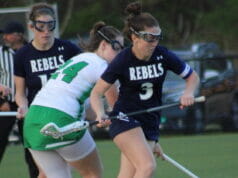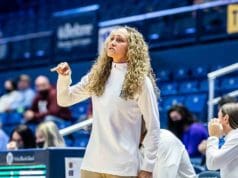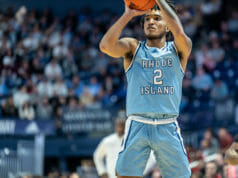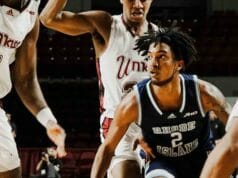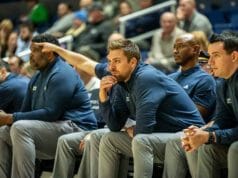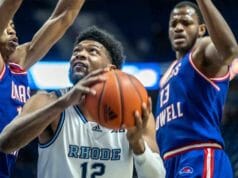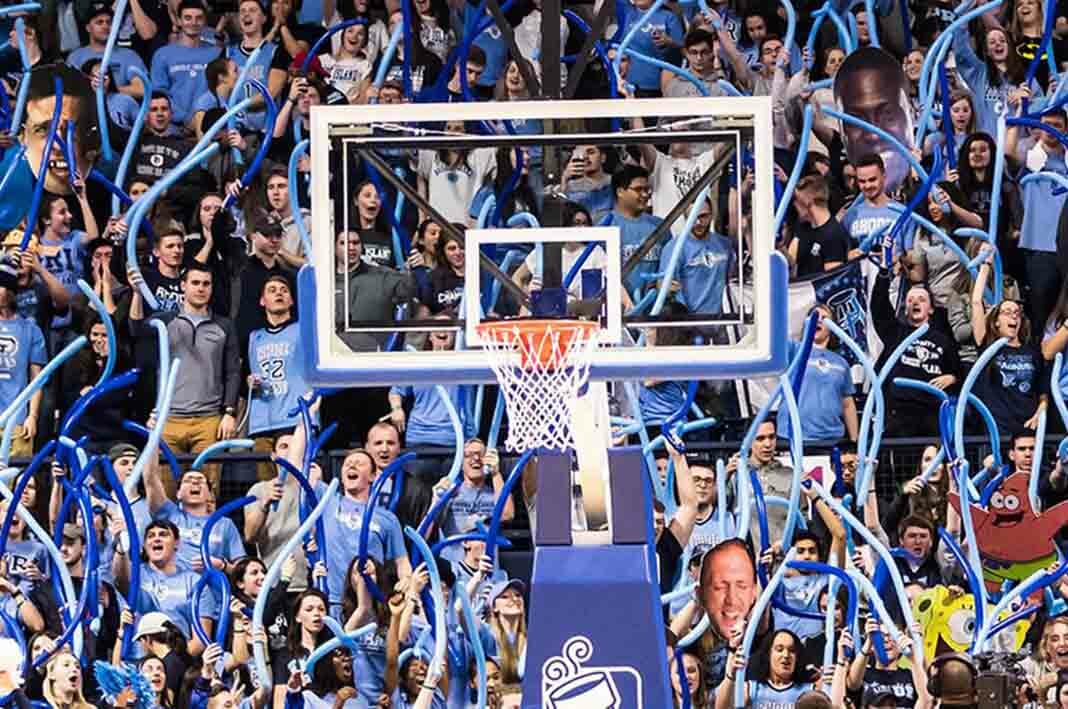
2020 has been unexpected, challenging, and arduous for most of us personally and professionally.
On the college athletics front, URI Director of Athletics Thorr Bjorn is in the thick of it. The Atlantic 10 recently postponed fall sports and the ever-evolving public health situation continues to necessitate communication, planning, and action.
I sat down with him for an enlightening discussion on the path forward over these next six weeks.
Chris DiSano: You are a veteran athletic director who has developed networks and relationships around the country. You’re well respected. Can you set the table by identifying the different committees, task forces and professional peer groups you contribute to currently?
Thorr Bjorn: Sure. Most recently, I am the chair of the athletic directors’ group in the Atlantic 10. I just finished my second year which normally completes the term, but the Commissioner (Bernadette McGlade) just asked me to stay on a third year under the circumstances, so I’m going to be doing that again. I’m a member of the FCS Selection Committee and just finished my second year of that. I just came off a two year term as the chair of the CAA Football group, and I just finished a four-year term on the NACDA Executive Committee representing FCS football. So I’ve been on a lot of different national committees and/or chair roles within our two leagues.
CD: In terms of the Atlantic 10 athletic director group, what has been the mode of operation for the group since the public health situation flared up?
TB: We meet every Thursday at 5pm on a Zoom call, without exception. Since campuses were closed back in March, we’ve been incredibly active, and conversations right up until last Thursday were “Are we playing fall sports?” That was a big part of the discussion obviously. As a group, including the presidents, we made the decision – really the presidents voted on it – to push everything off to the spring. That’s been the focus.
Our next focus, starting with this Thursday’s call, is what are the fall sports going to look like in the spring, what will be some of the restrictions based on the non-traditional fall season/spring season, so the logistics associated with what people can and can’t do – with a major emphasis on wanting our student athletes to be able to practice. That hasn’t been a big part of our conversation yet but we’ll be starting to lay the ground rules this week. Where things are different, Chris, is that with the NCAA not moving their fall championships yet, the traditional seasons are still the fall for soccer, FCS football, volleyball, etc. Until that changes, a lot of what we’re going to be doing may be on an island, so we have to navigate that as well.
CD: Let’s go back to the athletics directors’ group. I assume that is a working group; you’re rolling your sleeves up and getting a lot done. Did that group bubble up a recommendation to the presidents and then a decision was made?
TB: I would say that there was a lot of discussion and recommendations that we worked on within our group, and then that was bubbled up to the presidents. Then two weeks of discussion with president calls, is what led to the ultimate vote — and that’s a presidential vote. It was obviously that significant a decision.
CD: You talked about the A-10’s decision to shift its timetable but the championships remain. As you wrap your head around that what is the next step?
TB: It’s really now focusing back onto our campuses and providing assurances to our coaches. I have a student-athlete Zoom call this week with the emphasis of assurance. That we’re going to do everything we can to play these contests in the spring and play in a meaningful way. Even if the NCAA Championships aren’t taking place – maybe they take place in their current format and current days – do our student athletes have a chance to play for something, to compete for something? So that’s been a real focus.
On our own campus we’ve begun talking about it today. We have six weeks to plan now. We were planning to bring fall teams back to campus starting this week. Now we have six weeks to plan bringing an entire group back to campus and who has priority to facilities, who has practice times, what are the restrictions on practice times that are going to allow us to have access to facilities, etc. So there’s a lot of planning now that has to go really into the operational weeds. It’s not just as simple as flipping a switch.
CD: So, essentially, you’re saying you have all these student athletes that are competing for a lesser share of the facilities pie and the time-slice pie, correct?
TB: And staff pie. We compete a great level but we still share resources. You’re sharing trainers, for instance. We have trainers that work a particular sport in the fall and a different sport in the spring. Now they’re going to be spread thin. Media relations, as you know with Shane (Donaldson), Jodi (Pontbriand), and Michaela (Benford) and what they do with it as a three-person crew with some student help. There will be a lot of pull on people’s time. People are geared up for it. People are ready for it. I keep using the word, and I hate it but I don’t mean it in a defeatist way… it is what it is… it truly is what it is and we’ll get through it, but more importantly, we have to do that by providing a great experience for the student athletes.
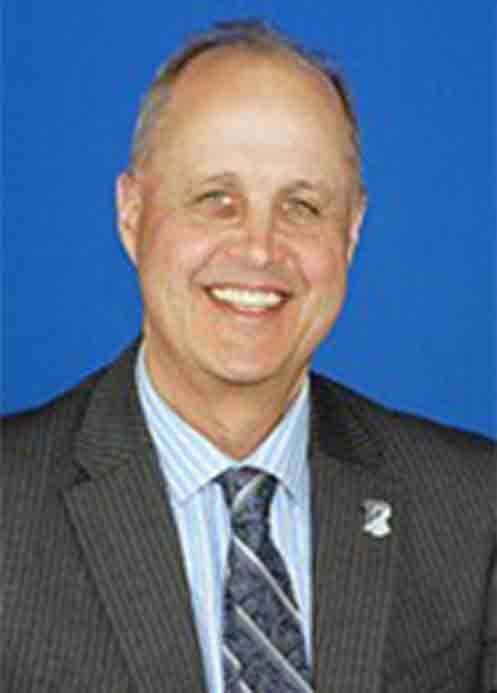
CD: We’ve discussed external communications. From an internal perspective, how often are you fostering exchanges with the coaching staffs, admin staff, etc.? What type of standing meetings do you have on updating them and how do you triage the timely and relevant questions coming in?
TB: Sure. It seems like Zoom or WebEx becomes an efficient use of your time and probably is, but I spend a lot of time on those calls every day. Twice a week – I’m on the President’s leadership team – we have calls that are an hour and a half to two hours long each time. I have two associate athletic director calls each week that are about an hour. We have a head coach and assistant coach call that we try to do every two weeks… and an all-staff, entire department, at least once a month. And then as I mentioned, we have an all student-athlete one. Because you’re not seeing everyone face to face, I know people get concerned when they don’t hear… so I’m trying to, as best I can, over communicate. And that’s never enough.
CD: You’re right; it’s not. But the more you build it into you default the better. As far as the student-athletes, particularly the fall sports whose season is minimally being flipped. I know you want to guarantee meaningful experiences, etc. How have the coaches been as ambassadors for the message and where do you feel things are heading into this week’s meeting?
TB: Well, the coaches have been great. And I’ve been fortunate enough to be part of a number of team calls with the coaches. It sounds corny and maybe the students think I’m not being totally honest, but it really is the highlight of my time. I love seeing them and it makes me smile and say to myself, “yeah this is what it’s all about.” So that’s why I’m looking forward to this week’s call with them. The messaging is important so long as it’s truthful, you can’t blow smoke. I feel very strongly that we can’t be misleading. I believe in the transparency piece. There’s nothing we have to hide. We did nothing wrong with COVID, it’s how are we going to adapt to it in the most safe way possible.
CD: When we think about the way that conferences have evolved and expanded like the A-10… That’s a geographic footprint that extends from Massachusetts to St. Louis. You have states and their own Departments of Health, a disparate set of variables and ways of dealing with this public health situation. How do you all stay together?
TB: The conference office has done a great job with this… and having these Thursday AD calls. We know it’s standing, it’s there. I’ve spent a lot of time on the phone with my colleagues. A lot of them are really good friends. I trust and count on them and I hope they feel the same way about me. We pick each other’s brains and we don’t always agree because, as you said, we’re in different geographical areas – but our goals are all the same. It’s a great group. By having these conversations and meetings, that’s keeping us more connected than in a normal year.
CD: Do you have any counterparts across the country – non-Atlantic 10 folks – who you call to bounce ideas off of from time to time?
TB: Yeah, I’m very fortunate with that. There’s a group of 5 AD’s that are across the country. It’s a call we started doing three or four years ago. A friend of mine who is now AD at North Dakota set it up when he was the AD at Eastern Washington, so it’s myself, him, the AD’s at South Dakota State, Montana State, and Cal Poly. We try to get together once a month and talk about the issues of the day.
And then, the CAA is another group I can get on the phone and talk with. And the fact that I’m on the FCS Selection Committee… I was on the phone last week talking with the AD of Jacksonville State and AD at Missouri State. Those guys have become good friends. The former chair whose at Central Arkansas has become a good friend. Having those folks that are going through the same challenges in different places makes you feel good, gives you some assurances whether you’re doing things right or wrong, and because they’re close friends their going to shoot straight and honest with you.
CD: Let’s sprinkle a few more in… How about winter sports?
TB: As of right now, our plan is going full steam ahead to plan those seasons in their entirety. If things change and we need to adjust, we will. We obviously don’t know what restrictions in the Ryan Center will be. No different than the fall, we work with a set of expectations and adjust as necessary, but right now the plan is full steam ahead to have a full basketball season.
CD: Although this year would be unfathomable for all of us if we weren’t living it, there are still short and long-term targets that must be met and rely on donor support. How have the URI donors been through this tumultuous time?
TB: The supporters in general have been great. People understand this is a unique time. Our fundraising had another really good year in spite of the fact that, for the most part, we haven’t participated in sports from March on. Our supporters realize that this is incredibly difficult financial times and we need their help more now than we did before. And people are stepping up to help. Season ticket numbers for sports were all pretty strong. The Rhody fans are passionate and I’m grateful for their support.
CD: Last one… I know we talked about this week’s student athlete meeting, but beyond that what is next for you operationally. What is the “immediate” next?
TB: The thing we’ve got to focus all of our time and attention on in the next six weeks is — students are coming back to campus in general, and student athletes are coming back to campus. We have to have a solid plan in place so once their physicals are complete and once they are cleared to practice, they know what they’re doing, they have a place to go, etc. It very well may be non-traditional, but we have to have everything articulated, written down, clearly identified – so that it’s as smooth as possible when they come back. That’s how I’m going to evaluate our level of success over these next six weeks.
(Interview Conducted Wednesday Evening, July 22, 2020)


